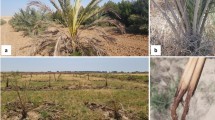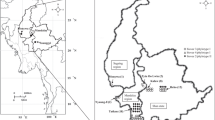Abstract
Thirty-six pathogenetic bacterial strains were isolated from wilted mulberry plants in Hangzhou, Zhejiang province of China. The six representative strains were confirmed to be involved in more than one Enterobacter species by common bacteriological test, electron microscope observation, hypersensitive reaction, Koch’s postulates, physiological and biochemical test, biolog, fatty acid methyl esters analysis (FAMEs), enterobacterial repetitive intergenic consensus-PCR (ERIC-PCR), 16s rRNA sequences analysis, and comparative analysis with 7 type strains and 3 reference strains. This is the first report on mulberry disease caused by Enterobacter spp. in the world providing new evidence on induction of the plant disease in this genus. The results are not only important in the mulberry disease management but also have significant scientific value for further studies of opportunistic human pathogens and environmental strains in Enterobacter.
Similar content being viewed by others
References
Ohl M E, Miller S I. Salmonella: a model for bacterial pathogenesis. Annu Rev Med, 2001, 52: 259–274 10.1146/annurev.med.52.1.259, 1:CAS:528:DC%2BD3MXhs1Khsb8%3D, 11160778
Perombelon M C M, Kelman A. Ecology of the soft rot Erwinias. Annu Rev Phytopathol, 1980, 18: 361–387 10.1146/annurev.py.18.090180.002045
Sanders W E J, Sanders C C. Enterobacter spp.: pathogens poised to flourish at the turn of the century. Clin Microbiol Rev, 1997, 10: 220–241 9105752
Iversen C, Forsythe S J. Risk profile of Enterobacter sakazakii, an emergent pathogen associated with infant milk formula. Trends Food Sci Technol, 2003, 14: 443–454 10.1016/S0924-2244(03)00155-9, 1:CAS:528:DC%2BD3sXotVChu7g%3D
Saddler G. Bacteria and Plant Disease 10. Oxford: Plant Pathologist’s Pocketbook, 2002
Nishijima K A, Wall M M, Siderhurst M S. Demonstrating pathogenicity of Enterobacter cloacae on macadamia and identifying associated colatiles of gray kernel of macadamin in Hawaii. Plant Dis, 2007, 91: 1221–1228 10.1094/PDIS-91-10-1221, 1:CAS:528:DC%2BD2sXhtFyjurvK
Kui Y Z. Recent progress of research on mulberry diseases. Sci Sericult (in Chinese), 2000, 26(s): 9–14
Martinez H R, Pinckard T R, Costa H S, et al. Discovery and characterization of Xylella fastidiosa strains in Southern California causing mulberry leaf scorch. Plant Dis, 2006, 90: 1143–1149 10.1094/PD-90-1143
Banerjee R, Manas D M, Ghosh P, et al. Genetic analysis of disease resistance against Xanthomonas campestris pv. mori in mulberry (Morus spp.) and identification of germplasm with high resistance. Arch phyto plant protection, 2007, 40: 176–182 10.1080/03235400500383727
Nishijima K A, Couey H M, Alvarez A M. Internal yellowing, a bacterial disease of papaya fruits caused by Enterobacter cloacae. Plant Dis, 1987, 71: 1029–1034 10.1094/PD-71-1029
Klement Z, Rudolph K, Sands D C. Methods in phytobacteriology. Budabest: Akademiai Kiado, 1990
Schaad N W, Jones J B, Chun W. Laboratory guide for identification of plant pathogenic bacteria. Minnesota: APS Press, 2001
Xu L H, Praphat K, Xie G L. Simple Technique of the Inspection for Mulberry Blight Ralstonia solanacearum. Bull Sericult (in Chinese), 2007, 38: 19–19
Xie G L, Soad A, Swings J, et al. Diversity of gram negative bacteria antagonistic against major pathogens of rice seed in the tropic environment. J Zhejiang Univ Sci, 2003, 4: 463–468 10.1631/jzus.2003.0463, 1:CAS:528:DC%2BD3sXms1ynsLs%3D, 12861624
Hoffmann H, Roggenkamp A. Population genetics of the nomenspecies Enterobacter cloacae. Appl Environ Microbiol, 2003, 69: 5306–5318 10.1128/AEM.69.9.5306-5318.2003, 1:CAS:528:DC%2BD3sXntlSjuro%3D, 12957918
Iversen C, Lehner A, Mullane N, et al. The taxonomy of Enterobacter sakazakii: proposal of a new genus Cronobacter gen. nov. and descriptions of Cronobacter sakazakii comb. nov. Cronobacter sakazakii subsp. sakazakii, comb. nov., Cronobacter sakazakii subsp. malonaticus subsp. nov., Cronobacter turicensis sp. nov., Cronobacter muytjensii sp. nov., Cronobacter dublinensis sp. nov. and Cronobacter genomospecies 1. BMC Evol Biol, 2007, 7: 64 10.1186/1471-2148-7-64, 17439656
Cole J R, Chai B, Farris R J, et al. The Ribosomal Database Project (RDP-II): sequences and tools for high-throughput rRNA analysis. Nucl Acids Res, 2005, 33: D294–D296 10.1093/nar/gki038, 1:CAS:528:DC%2BD2MXisVerug%3D%3D, 15608200
Fernandez-Baca V F, Ballesteros J A, Hervas P, et al. Molecular epidemiological typing of Enterobacter cloacae isolates from a neonatal intensive care unit: three-year prospective study. J Hosp Infect, 2001, 49: 173–182 10.1053/jhin.2001.1053, 1:STN:280:DC%2BD3MnntVyrsQ%3D%3D, 11716634
Chenna R, Sugawara H, Koike T. Multiple sequence alignment with the Clustal series of programs. Nucl Acids Res, 2003, 13: 3497–3500 10.1093/nar/gkg500
Hall T A. BioEdit: a user-friendly biological sequence alignment editor and analysis program for Windows 95/98/NT. Nucl Acids Symp Ser, 1999, 41: 95–98 1:CAS:528:DC%2BD3cXhtVyjs7Y%3D
Tamura K, Dudley J, Nei M, et al. MEGA4: Molecular evolutionary genetics analysis (MEGA) software version 4.0. Mol Biol Evol, 2007, 24: 1596–1599 10.1093/molbev/msm092, 1:CAS:528:DC%2BD2sXpsVGrsL8%3D, 17488738
Saitou N, Nei M. The neighbor-joining method: A new method for reconstructing phylogenetic trees. Mol Biol Evol, 1987, 4: 406–425 1:STN:280:DyaL1c7ovFSjsA%3D%3D, 3447015
Tamura K, Nei M, Kumar S. Prospects for inferring very large phylogenies by using the neighbor-joining method. Proc Natl Acad Sci USA, 2004, 101: 11030–11035 10.1073/pnas.0404206101, 1:CAS:528:DC%2BD2cXmsVCmt7s%3D, 15258291
Lai W J, Tan B A, Chen J Y. Isolation and diagnosis of mulberry wilt disease. Guangdong sericult (in Chinese), 1982, 2: 4–5
Buyer J S, Roberts D P, Russek C E. Soil and plant effects on microbial community structure. Canadian J Microbiol, 2002, 48: 955–964 10.1139/w02-095, 1:CAS:528:DC%2BD3sXntlyjsw%3D%3D
Van de Peer Y, De Wachter R. TREECON for Windows: a software package for the construction and drawing of evolutionary trees for the Microsoft Windows environment. Bioinformatics, 1994, 10: 569–570 10.1093/bioinformatics/10.5.569
Altschul S F, Gish W, Miller W, et al. Basic local alignment search tool. J Mol Biol, 1990, 215: 403–410 1:CAS:528:DyaK3MXitVGmsA%3D%3D, 2231712
Grimont F, Grimont P A D. New York: The Prokaryotes.: Springer, 1992
Zhang L X, Xie G L. Diversity and distribution of Burkholderia cepacia complex in the rhizosphere of rice and maize. FEMS Microbiol Lett, 2007, 266: 231–235 10.1111/j.1574-6968.2006.00530.x, 1:CAS:528:DC%2BD2sXpsVygtQ%3D%3D, 17233735
French C E, Nicklin S, Bruce N C. Aerobic degradation of 2,4,6-Trinitrotoluene by Enterobacter cloacae PB2 and by Pentaerythritol Tetranitrate Reductase. Appl Environ Microbiol, 1998, 64: 2864–2868 1:CAS:528:DyaK1cXlsVKhtLs%3D, 9687442
Nie L, Shah S, Rashid A, et al. Phytoremediation of arsenate contaminated soil by transgenic canola and the plant growth-promoting bacterium Enterobacter cloacae CAL2. Plant Physiol Bioch, 2002, 40: 355–361 10.1016/S0981-9428(02)01375-X, 1:CAS:528:DC%2BD38XivValsbs%3D
Watanabe K, Abe K. Graduate School of Agricultural and Life Sciences, The University of300Tokyo, Bunkyo-ku, Tokyo, Japan, Sato M. Biological control of an insect pest by gut-colonizing Enterobacter cloacae transformed with ice nucleation gene. J Appl Microbiol, 2000, 88: 90–97 10.1046/j.1365-2672.2000.00904.x, 1:STN:280:DC%2BD3c7pslaqtg%3D%3D, 10735247
Chernin L, Ismailov Z, Haran S. Chitinolytic Enterobacter agglomerans antagonistic to fungal plant pathogens. Appl Environ Microbiol, 1995, 61: 1720–1726 1:CAS:528:DyaK2MXlsFyksbg%3D, 16535017
Tarraga A M C, Bentley S. Animal, vegetable or mineral? Nat Rev Microbiol, 2006, 4: 725–726 10.1038/nrmicro1508
Author information
Authors and Affiliations
Corresponding author
Rights and permissions
About this article
Cite this article
Zhu, B., Wang, G., Xie, G. et al. Enterobacter spp.: A new evidence causing bacterial wilt on mulberry. Sci. China Life Sci. 53, 292–300 (2010). https://doi.org/10.1007/s11427-010-0048-x
Received:
Accepted:
Published:
Issue Date:
DOI: https://doi.org/10.1007/s11427-010-0048-x




